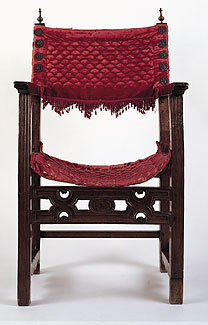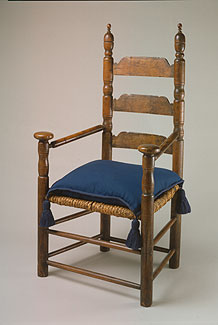Taking
a Chair
|
|
In the colonial
era, most people did not sit on chairs as we do today. In the British
colonies, people sat on backless benches or stools. In viceregal
Mexico, people sat on cushions on the floor, a Spanish tradition
adapted from the Moors. This Spanish chair from the 1500s and the
1640 Great Chair from Massachusetts reveal that chairs were
reserved for important people.
|
|
|
|
|
Armchair
Franz Mayer Collection
|
Great
Chair
Bayou Bend Collection
|
|
|
|
Materials
The
armchair is carved from wood. The red velvet is attached to the
wood with bronze nails. Velvet was a rare luxury item.
|
Materials
The
chair is carved from maple and oak and has a rush seat.
|
Decoration
The
crossbars connecting the legs below the seat feature fretwork
and carved motifs called riñoncillos or kidneys.
Fluting, horizontal incised carving, adorns the front legs. The
bronze nail heads attaching the velvet have a floral motif, and
bronze finials stand atop the backrest.
|
Decoration
The
artist created the rounded forms and lines decorating the front
and back chair posts by turning the wood on a lathe. At the top
of back posts are oval decorations topped with a small finial.
The rounded, mushroom-shaped decoration at the top of the front
posts is very distinctive.
|
Chairs
in Colonial Mexico
Chairs
were not commonly used in Mexican homes until the 18th century.
Following the Moorish tradition from Spain, people sat on stools
or cushions. Chairs were primarily used by important church officials
|
Chairs
in Colonial America
In
the 17th century, only wealthy families owned chairs with backs.
Most households had only one or two chairs which were reserved
for the male head of the household and perhaps an honored guest.
Women and children, if they were lucky, sat on backless stools.
A "Great Chair" like this emphasized the status of the
family who owned it, and in particular, the person important enough
to sit in it.
|


